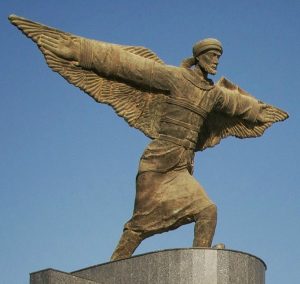The first person to make a real attempt to built a flying machine and bring it into the air was Muslim scientist Abbas ibn Firnas in the 9th century in the city of Cordoba, Spain. He acquired the knowledge of flight through the study of birds.

Image source: https://www.flickr.com/photos/eliasroviello/44376324450 Author: Elias Rovielo
History is full of legends and fables of men trying to fly. Including Icarus who flew so close to the sun that the wax that held his feathers melted and then fell into the sea and drowned. The first successful attempt at flight was made by the Chinese flying kites around the 5th century BCE but the first successful attempt at human flight was made by a Muslim, Abbas ibn Firnas in 875 CE in the city of Qurtuba Al-Andalus (Cordoba, Spain).
Who was Abbas ibn Firnas?

Image source: https://commons.wikimedia.org/wiki/File:Ibn_Firnas,_father_of_aviation.jpg
Abbas Ibn Firnas was born in Izn-Rand Onda Al-Andalus (now Ronda Spain) but lived in the Emirate of Cordoba, one of the major learning centers in the Muslim world. He was a multifaceted: inventor, engineer, aviator, physician, and Arabic poet.
The first attempt
The stories say that Ibn Firnas was influenced by the one named Armen Firman in 852 CE. He was a person who made a living doing stunts, he was not a scientist but through observing the nature around him and relying on a rudimentary understanding of the mechanics of flight, he built a silk dress with wood-reinforced rods. With this machine, Armen Firman climbed to the top of a minaret of the grand Qurtuba mosque and jumped. He was unable to fly, he crashed, yet his flying contraption swelled just enough to slow his fall. Hitting the ground he was slightly injured, but he was neither dead nor crippled. This was probably the first parachute jump in the world.

Image source: https://commons.wikimedia.org/wiki/File:Ibn_Firnas%27_statue.jpg
The second attempt
In 875, about 23 years after Armen Firman, the 70-year-old Ibn Firnas built his flying machine after studying the nature of flight among his other studies. He built a pair of silk and wood wings and sewed real feathers. From the hills of Jabal Al-‘Arus, he jumped off a cliff. He would have glided for a considerable amount of time, some witnesses claimed it felt like 10 minutes.

Image source: https://commons.wikimedia.org/wiki/File:Ibn-firnas-cordoba.png
Towards the end of his descent, he realized there was a problem with his project. He had concentrated his energy on the study of take-off mechanics but neglected the mechanics of landing. He descended at great speed, unable to control it, and once he fell to the ground, he was seriously injured.
How did he create it?
To achieve sufficient lift to support his weight, Abbas bin Firnas built wings with an estimated span of between four and five meters. To keep the flying machine strong and light, he made a lightweight wooden frame, probably using bamboo, hollow like a bird’s wing bones.

Image source: https://aertecsolutions.com/en/2018/05/21/abbas-ibn-firnas-the-first-man-to-fly-and-live-to-tell-the-tale/ Author: Antonio Rodríguez-Laiz
The parts of the frame were tied together with thin strips of silk, considered the lightest and most resistant material at the time, and which was also used as a fabric covering for the wings. Finally, he covered the wings and clothes with an eagle feather. Abbas bin Firnas manufactured a harness system that allowed him to hover under the flying machine and control the movements of the wings with the help of handles. Considering that advanced age of Abbas bin Firnas and the consequent physical limitations, the movements of the wing were also probably limited.
Info sources: https://www.muslimink.com/ https://en.wikipedia.org/wiki/Abbas_ibn_Firnas https://ilmfeed.com/the-worlds-first-aviator-abbas-ibn-firnas/ http://muslimsincalgary.ca/the-bird-man-abbas-ibn-firnas/
